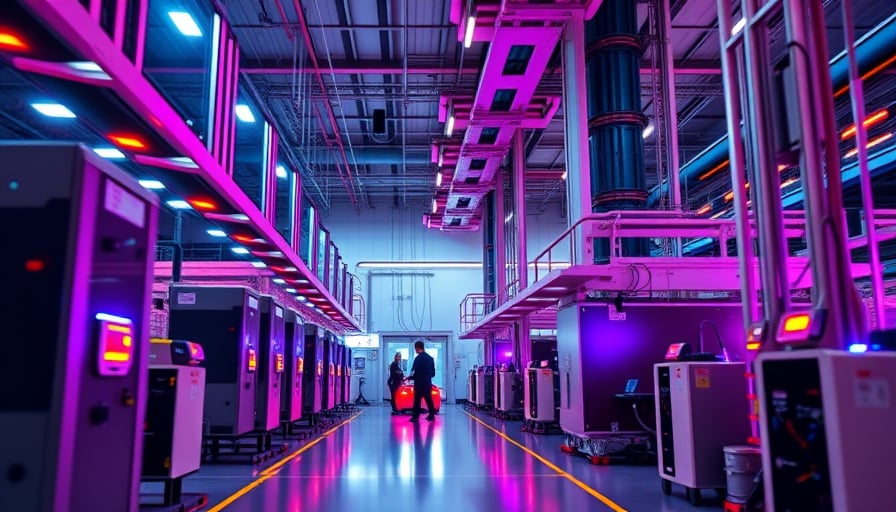ASML Holding NV: Navigating Technological Edge Amid Geopolitical Uncertainty
Executive Summary
ASML Holding NV, the Dutch titan behind lithography systems that enable the world’s most advanced semiconductor manufacturing, continues to command investor interest. While its share price hovers near recent highs, signaling confidence in its leadership of the high‑performance chip sector, analysts caution that looming export restrictions and escalating tensions between major economies may temper optimism. This article investigates how ASML’s technological dominance intersects with geopolitical dynamics, the implications for supply chain resilience, and the broader societal, privacy, and security ramifications of its flagship products.
1. Technological Leadership and Market Position
1.1 The Lithography Imperative
Semiconductor fabrication relies increasingly on extreme ultraviolet (EUV) lithography. ASML’s EUV machines—costing upwards of €1.3 billion each—are the only commercial toolset capable of producing 7‑nm and 5‑nm nodes. The company’s EUV productivity (chips per hour) has improved by 25 % year‑over‑year, driven by advances in source power and mask‑repair algorithms. This translates directly into higher yields for fab operators such as TSMC, Samsung, and Intel, positioning ASML as an indispensable enabler of Moore’s Law.
1.2 Market Share Dynamics
According to Gartner and IHS Markit, ASML holds roughly 70 % of the EUV lithography market, with the remainder split between NXP and a nascent Chinese entrant that has yet to achieve comparable performance. The company’s sales to the United States, Taiwan, and Japan account for 60 % of its revenue, underscoring its concentration in the “safe” geographies that maintain a competitive edge in chip design and manufacturing.
2. Geopolitical Tensions and Export Controls
2.1 U.S.-China Trade War Fallout
The 2020 U.S. “CHIPS Act” and the subsequent Export Administration Regulations (EAR) have tightened restrictions on the sale of advanced semiconductor equipment to certain Chinese entities. In 2021, the U.S. Commerce Department added the Shanghai-based SMIC to the Entity List, effectively banning the sale of EUV machines and critical software. While ASML has complied—terminating sales to SMIC and its subsidiaries—this move constricts its potential revenue from the largest emerging market for semiconductors.
2.2 European Union’s Response
The European Commission has expressed concern about the concentration of critical semiconductor tools in the hands of a single Dutch firm. In 2023, it launched an EU‑wide “Semiconductor Innovation Fund” to encourage domestic chip manufacturing and to reduce dependency on foreign lithography systems. If the EU subsidizes alternative providers, ASML could face pressure to lower prices or share proprietary technology, potentially eroding its high-margin business model.
2.3 Potential Market Sentiment Shifts
Analysts suggest that as export restrictions tighten, valuation models for ASML may need recalibration. The company’s price‑to‑earnings ratio, currently at 45×, is heavily predicated on continued dominance in the EUV market. A sudden loss of market share or a price war with a new entrant could compress margins and push the stock further down the valuation ladder.
3. Supply Chain Resilience and Human Impact
3.1 The “Just‑In‑Case” Paradigm
ASML’s equipment demands a highly specialized supply chain: rare‑earth magnets, ultra‑pure silicon, and precision optics. In 2022, the global rare‑earth supply shock—stemming from Chinese export quotas—highlighted the fragility of this ecosystem. ASML’s rapid diversification of suppliers in Brazil and Australia mitigated disruption, yet the incident underscored that a single point of failure can ripple across the entire semiconductor industry, affecting everything from smartphones to autonomous vehicles.
3.2 Workforce Considerations
The company’s R&D workforce is predominantly located in Veldhoven, Netherlands, with satellite centers in Germany and the United States. Recent reports indicate a skills gap in advanced photolithography, prompting ASML to partner with universities to cultivate the next generation of optical engineers. These initiatives not only safeguard the company’s intellectual capital but also generate local economic benefits and help address the broader global talent shortage in high‑tech sectors.
4. Societal, Privacy, and Security Implications
4.1 Dual‑Use Concerns
EUV lithography enables the production of chips with unprecedented power density, facilitating devices from wearable health monitors to military drones. However, the same technology can be employed to produce low‑cost, high‑performance computing platforms that enable sophisticated cyber‑weaponry. As a result, the U.S. and allied governments have intensified scrutiny over ASML’s export controls, demanding stricter compliance regimes and periodic audits.
4.2 Data Privacy and Embedded Systems
The proliferation of chips that power IoT devices raises concerns over data leakage and privacy erosion. ASML’s lithography systems are foundational to the manufacture of secure enclaves, but any compromise at the fabrication stage—such as through hardware Trojans—could undermine the integrity of entire ecosystems. Investigators argue that industry standards for secure hardware design must evolve in tandem with manufacturing capabilities.
4.3 Cybersecurity of the Tooling Itself
ASML’s equipment is not immune to cyber‑intrusions. In 2020, a simulated attack on an EUV system revealed vulnerabilities in the machine’s Ethernet control interface. Subsequent firmware updates have mitigated these risks, but the episode underscores the necessity of robust cyber‑defense protocols within the semiconductor tooling supply chain, especially as remote operation becomes more prevalent.
5. Risk–Benefit Assessment
| Risk | Potential Impact | Mitigation |
|---|---|---|
| Export restrictions to China | Loss of ~10% revenue, increased regulatory scrutiny | Diversify customer base; engage in diplomatic dialogues |
| Price competition from new entrants | Margin erosion, slower growth | Protect IP; offer bundled services and after‑sales support |
| Supply chain shocks (rare‑earth, optics) | Production delays, cost spikes | Dual sourcing; strategic stockpiling |
| Cyber‑security threats | Intellectual property theft, operational downtime | Advanced threat detection, secure firmware lifecycle |
Benefits remain substantial: ASML’s continued leadership in EUV technology ensures a high barrier to entry for competitors and preserves its premium pricing. Additionally, its role in enabling low‑power, high‑performance chips directly supports sustainable tech initiatives, such as energy‑efficient data centers and green electronics.
6. Conclusion
ASML Holding NV exemplifies the intersection of cutting‑edge technology and complex geopolitical realities. While its lithography systems underpin the most advanced semiconductor fabs worldwide, the company’s fortunes are increasingly intertwined with international trade policies, supply‑chain resilience, and the evolving landscape of cyber‑security and data privacy. Investors and policymakers alike must weigh the company’s robust market position against the potential for regulatory tightening and emerging competition. The broader societal implications—ranging from the democratization of high‑performance computing to the safeguarding of privacy—underscore that ASML’s influence extends far beyond the boardroom, shaping the very fabric of modern digital life.




